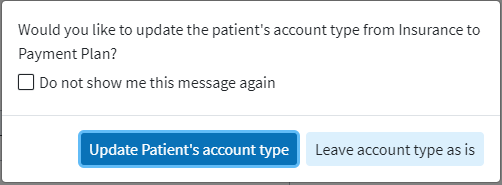Select Patient > Payment Plans.
Search for your desired patient by typing the name, DOB, account #, member id, or phone #.
 You can also Search by insured, Search inactive patients or search Show exact matches only by checking the respective boxes.
You can also Search by insured, Search inactive patients or search Show exact matches only by checking the respective boxes.
Click Search.
Select the Patient you want to create a payment plan for.
Click the New Payment Plan button.
Determine the Payment Plan Amount by selecting one of the following options.
If there are no existing charges to associate to this payment plan: The payment plan will not be associated with any charges, any patient payments will be converted to payment plan credits. We recommend you use this option if you plan to add changes to this payment plan at a later time.
 If you are creating a payment plan that is unrelated to any charges, we recommend using a Debit Code, and assigning it to the payment plan.
If you are creating a payment plan that is unrelated to any charges, we recommend using a Debit Code, and assigning it to the payment plan.Populate the Payment Plan Amount.
If there are one or more existing charges that this payment covers: The payment plan will be associated with a charge, and patient payment will be posted to the associated charge.
Click the Add Charge button
Select the Changes you want to associate with this payment by checking the box(es) and clicking Done.
Populate the Payment Plan Amount.
Place a check in the Set to charge total to set the payment plan amount to the due balance amount for the associated charges.
Click Continue.
Generate Payment Plan Installments, due dates, and the amount due for each installment.
 A maximum of 200 installments can be added to a payment plan.
A maximum of 200 installments can be added to a payment plan. To Auto Generate installments, configure the following options:
First Payment Plan Date: Select the due date of the first payment.
Use the Payments Due every drop-down menu to specify the frequency of the payment due date.
Select one of the following options to auto-generate installments:
- Each Installment Amount: Enter the expected payment amount that will be due for each installment. Select this option for the system to automatically calculate the number of installments.
Each Total Number of Payments: Select this option to have the system automatically calculate the amount due based on the number of installments you enter.
Last Payment Date: Select this option to have the system automatically calculate the number of installments and amount due until the date you enter.
Click Generate Installments.
The installment amount, due date, and description will appear and can be modified by clicking in the corresponding column.

To Manually Generate Installments, complete the following:
Click the Add Installment button.
Enter the Installment Due Date and Amount Due until you have entered all installment dates and amounts.

Click Continue.
Review your payment plan details.
Write a description about this payment plan for other users to reference.
Use the Practice drop-down menu to select which practice the payment plan should report under.
Optional: Place a check in the Set up Auto Pay checkbox to set up Automatic Payments for the payment plan installments.
Click Save.
Check the Cardholder has consented to Auto Pay box.
Click Next.
If a card was previously saved, you have the option to “Use a saved card” otherwise select “Use a different card.”
Click Save.
Enter the card information and check the “Save my payment information for next time” checkbox.
Click Save.
 If the patient’s account type is not set to “Payment Plan”. You will have an option to update the account type to “Payment Plan”.
If the patient’s account type is not set to “Payment Plan”. You will have an option to update the account type to “Payment Plan”.
 Don't want to worry about collecting patient payment for each installment date? With the patient's permission, enable Auto Pay so you never miss out on a payment plan payment again. Visit our Enable Auto Pay for a Payment Plan Help Article for detailed steps.
Don't want to worry about collecting patient payment for each installment date? With the patient's permission, enable Auto Pay so you never miss out on a payment plan payment again. Visit our Enable Auto Pay for a Payment Plan Help Article for detailed steps.
 You can also Search by insured, Search inactive patients or search Show exact matches only by checking the respective boxes.
You can also Search by insured, Search inactive patients or search Show exact matches only by checking the respective boxes. A maximum of 200 installments can be added to a payment plan.
A maximum of 200 installments can be added to a payment plan. 

 If the patient’s account type is not set to “Payment Plan”. You will have an option to update the account type to “Payment Plan”.
If the patient’s account type is not set to “Payment Plan”. You will have an option to update the account type to “Payment Plan”.